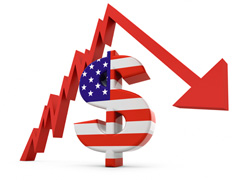During recent FXCC market commentaries and updates, we’ve discussed the significant collapse USD has experienced versus its peers. In recent weeks EUR/USD has reach highs not seen since May 2018, while in a correlated sell-off USD/CHF has slumped to levels last witnessed in January 2015.
The fall in USD/CHF shouldn’t be overlooked or dismissed. We’re looking at one former safe-haven currency (USD) becoming usurped by another (CHF). The Swiss franc has been regarded as a safe option, providing value during turbulent times for decades. The overall uncertainty provided by the Covid pandemic has caused a rush to invest in the Swissy.
Meanwhile, the close on $4 trillion of fiscal and monetary stimulus the USA government and Federal Reserve has indulged in during 2020 has also hammered the value of USD, and a leading analyst thinks the US dollar has much further to fall in 2021.
Don’t fight the Fed
Goldman Sachs expects the dollar to fall next year as the global economy recovers and investment allocation shifts into riskier assets. Speaking on “Bloomberg Surveillance, Kamakshya Trivedi, Goldman’s co-head of global FX interest rates and emerging-markets strategy research, believes USD could collapse “by roughly 5% to 6% on a trade-weighted basis in the coming year.”
His reasoning appears robust; investors will rotate out of USD and continue to pile into equities as both the Biden administration and the Fed engage in several trillions of dollars worth of Covid recovery stimuli during 2021 at the expense of the dollar.
Weekly tale of the tape for USD week ending December 4
EUR/USD rose by 1.33% weekly and is up 2.57% monthly.
GBP/USD rose by 0.92% weekly and is up 2.25% monthly.
USD/CHF fell by -1.44% weekly and is down -1.41% monthly.
USD/CAD fell by -1.62% weekly and is down by -2.26% monthly.
Macroeconomic events to monitor closely, week commencing December 6
Although it’s a somewhat repetitive cycle, there are times in our trading careers when the textbook for fundamental analysis needs to close because monumental and historical events take precedence. We have the black swan of Covid with the promise of vaccines and Brexit which are dominating just about all FX and equity market chatter and movement at the moment.
The final Brexit date is approaching
The patience the EU Brexit team have displayed during the various provocations from their British counterparts has been admirable. But unfortunately, the UK bluster has hit the buffers as negotiations are now reaching the end. There is no more road to kick the can down.
The Vote Leave politicians promised the UK electorate single market access and freedom of movement after Brexit. Whereas, the UK are losing frictionless trade and all four tenets of free movement. From January 1, the UK public is losing the free movement of goods, services, finance, and people.
The UK pound increased in value versus USD during November. The markets can attribute the 2.21% rise of GBP/USD to the US stimulus; the rise is due to the collapse in the dollar, not GBP strength.
Versus the euro sterling is down -6.61% year to date; EUR/GBP is trading at 0.902 up 0.44% weekly, at the start of 2020 the single bloc euro currency was exchanging at 0.840 per pound.
When the London session opens on Monday, December 7, UK government negotiators will have three working weeks before the January 1 exit. Haulage firms are predicting chaos and trade bodies in the UK believe fresh foodstuff and produce might rise in cost by 35% once tariffs are applied.
We can confidently expect all GBP pairs to experience increased trading volatility during the next three weeks. Naturally, EUR/GBP and GBP/USD will be the most popular trades during the period due to both pairs getting used by institutional level traders to hedge exposure on behalf of their clients. The spreads quoted for both currency-pairs are consistently tight, which makes them attractive to both day and swing traders.
USA equity markets take out record highs despite a desperately low NFP reading
The NFP jobs number printed on Friday missed the forecast by some distance. Reuters had predicted 469K jobs created in November, and the actual reading was 245K.
As an example of our current upside-down financial world, the markets reacted positively to this shocking number which should also include seasonal hires. In an all too familiar reaction, market analysts and traders quickly realised that the Fed and US government would feel compelled to engage in further stimuli.
A new paradigm now exists; terrible domestic economic news is good news for the USA equity markets, once again indicating that our previous textbook analytical skills are largely redundant during the current times. During recent commentaries, we’ve encouraged clients to maintain vigilance to breaking news events combined with monitoring the economic calendar. Clients should continue to adopt this twin policy of analysis for the foreseeable future.


